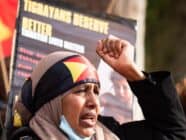Immigration is topically tempestuous in nations the world over. In Germany, however, the subject is debated with near-Olympic rigor as the struggle to etch out a relationship with foreigners proves to be one of great longevity. Strident debate is routinely splayed across headlines with coverage too often adhering to the adage “good news is no news.”
This is not simply a tangle of today, but an evolving situation of complexity fanned by Germany’s mainstream media. The matter requires contextualization – to say the least – and dates back to the nascence of large-scale immigration to Germany.
The Guests
Before the mid-Twentieth century, Germany had been a place of emigration. The first “guest workers” (Gastarbeiters) arrived during the 1950s and 1960s and received temporary work and residence permits in response to the country’s recruitment policies. Italian, Spanish, Greek and Portuguese workers filed in. Though the new laborers were vital in sustaining a booming economy, the German press pegged them as temporary guests to be tolerated, with their desirability contingent on contributions to economic development.
The economic crisis of 1973 brought recruitment to a halt, yet family reunification policies ensured a continued stream of immigrants, yielding a steady flow of wives and children. As crisis bore down on the economy, a shift in Germany’s hospitality became evident in headlines and news reports. Those formerly considered “guests” were now portrayed as societal barnacles. With the fall of the Berlin Wall and collapse of the Iron Curtain, the news conceptualization of “immigrant” transformed once again, with mainstream outlets like Der Spiegel and Bild Zeitung routinely deferring to “illegitimate refugee” typologies and emphasizing grave, embellished ramifications.
Mass immigration from the Balkans and Eastern Europe in the late 1980s and early 1990s coupled with asylum seekers fleeing conflict in Turkey, the Middle East and Africa furthered an intensified debate. Asylum applications and migration flow spiked in the mid-1990s, with xenophobia and terse socioeconomic tensions mounting in tandem.
In 2000, introduction of a new German naturalization law which reconfigured the antiquated principle of ius sanguinis (citizenship by blood) to include ius soli (citizenship by birth) incited further contention. Prior to the new proposal, a 15-year stay in Germany was required for naturalization and dual citizenship was not permitted. The new citizenship law – which granted German-born children of immigrants citizenship for the first time – inspired polemic media invectives rife with cliché (“Das Boot ist voll”), and featured immigrant crime as a highly popular, persistent subject of news coverage. The new naturalization law drove grand schisms in the political sphere and amplified Germany’s struggle to find balance in immigrant integration policy.
Post 9/11 brought magnified attention to Islam and immigrants of Muslim descent (as was the case in many places outside the Unites States) and the Muslim population in Germany swelled to unprecedented proportions. Germany is home to approximately 16 million people with immigrant backgrounds, and between 3.0 – 3.5 million Muslims, although the German Federal Agency for Statistics does not provide data about the religious orientation of the population (only data on the basis of citizenship is available and can serve for estimations). Still, it is the largest Muslim concentration in Western Europe after France, and coverage of this population growth has been predominantly negative – with disproportionate attention devoted to vitriol-inciting topics like honor killings, arranged marriage and terrorism.
Fortunately, the mainstream media’s pejorative focus on immigration has not gone unchallenged. Immigrant organizations repeatedly chastise the media for dispersing fragmented, inaccurate images of immigrants in Germany by ignoring the mundane, “ordinary” facets of living. Groups like the Neue deutsche Medienmacher (New German Media-Maker), a nation-wide organization of journalists, formed to advocate pluralism and combat stereotypes in the media. And over time, examples of nuanced portrayals of the immigrant experience have emerged due – for the most part – to individuals with immigrant backgrounds penetrating the media scene and offering diversified perspective.
Social diversity in Germany is increasingly acknowledged as a resource and integration initiatives have broadened, yet this recognition was neither championed nor propelled by the German mass media. In her National Action Plan on Integration, Chancellor Angela Merkel emphasized the demand for more immigrant representation in the media, though specialized press outlets, public broadcasters and migrant organizations had been proponents long before. Holding steadfast to myopic perspectives, the mainstream press themselves didn’t budge until policymakers inched toward new social integration policies.
All Immigrants or Only the Ones With Beards?
Despite inspiring impassioned conjecture (and research initiatives) from all sides, detailed studies and discussion on migration movements tend to be androcentric, often based predominantly on the male migrant experience. What we know of the interplay between the German media and depictions of female immigrants is considerably less.
In response to this concentrated gap, Professor Margreth Lünenborg, Director of the International Center for Journalism at the Freie Universität Berlin, took to the task of analyzing ways in which female immigrants are represented in German mass media. “After we had a first look at the literature, we could see that there does appear to be this stereotype of the ‘aggressive migrant’ or the ‘threatening migrant’ discussed in a broad sense,” she says. “However looking closely in detail you can see that it’s quite often a male figure being referred to – at least implicitly.”
This observation lead Lünenborg to question the ways in which the media construes a female immigrant, or if such a construction even exists at all. In order to probe the question further, she conducted an intersectional analysis specifically focused on the image of female migrants in German media – an undertaking provoked in part by a 2005 incident in which a young Turkish woman was murdered by her brother in Berlin. The event, of course, sparked vituperative discussion in newspapers and tabloids nationwide.
Lünenborg’s study, “Female Immigrants and the Mass Media,” addresses the relevance of media representations for self and public perception and is divided into sub-projects, concerning both audio-visual media and representations in the press.
The newspaper facet of the study analyzed representations of female migrants in selected print media by way of a systematic, empirical exploration of the interrelation among structural categories of gender and ethnicity in media coverage. In this component, five German newspapers (Kölner Stadtanzeiger, Westdeutsche Allgemeine Zeitung, BILD, tageszeitung and Frankfurter Allgemeine Zeitung) were analyzed during one month of each year from 2005 – 2010. From here, “types” were identified and structured into different groups (the victimized migrant, the sexualized migrant, the stigmatized migrant and so forth).
According to Lünenborg, the female “victim” typology was found to be the most prominent and appeared across the board, although perhaps not necessarily in the papers one might predict. “Interestingly enough we have this left-leaning paper in Berlin, tageszeitung,” she explains. “They do a lot of coverage in the field of migration, really focusing on issues, but unfortunately they use this victim type the most often in the way they frame stories.” Migrants are scarcely depicted as academics relocating to new countries, or athletes, or artists. “Being aware of migration as a global process for very different reasons is not framed as a form of being a migrant,” says Lünenborg.
Interestingly enough, the political segments of the newspapers were the most heavy-handed in employing stereotypical depictions of female immigrants. “The more you venture into the political desk, the more stereotyped the way of describing female migrants is,” she says. “At the political desk they’ll discuss migration issues in general. They’ll discuss sexual trafficking or the need for educational help – but they use broad political frames and rarely discuss migrant people as individuals, preferring to speak of them as an anonymous mass.”
Visual imagery is no exception to this rule, leaning toward stock, one-dimensional illustrations. “The photography they use in this kind of reportage is that of – typically – a Muslim woman wearing a skirt down to her ankles, having two or three children at each side, really appearing anonymous and not as a subject to be identified. That’s the picture we often find in political discourse.”
Additionally, the study drew focus groups comprised of women with both migrant and non-migrant backgrounds to discuss media images and coverage. The women reported feeling greatly offended and misrepresented by the reportage, stating that it was one-sided and negatively biased. “If we think about journalism as being an institution to construct society, to integrate different persons in society, we could really see that these people could not envision themselves being included in society,” Lünenborg explains.
Toward a Heterogeneous Future
While a new degree of awareness and sensitivity may have been raised, German journalism still remains something of a white male gerontocracy. The diversity of Germany’s immigrant community is not reflected in media, as easily evidenced by tuning into most any TV news program, where anchors are by and large a homogenized milky breed (plus one for good measure).
For news to reflect the accuracies of life in this country, it must draw on the minds, cultures and perspectives of those living here. As it happens, they’re a motley bunch.
See bibliography and references here.
Photo credits: diegofornero / Flickr CC
Tags: Cultural Reporting, Freie Universität Berlin, German Journalism, German Media, Germany, Margreth Lünenborg, Migrants, Minority Communities, Minority Issues









































